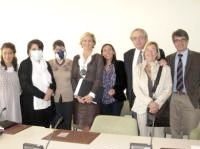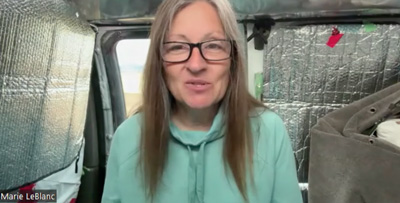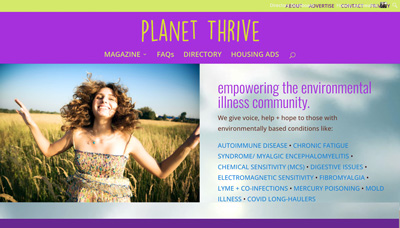 source: www.asquifyde.es
source: www.asquifyde.es
Attendees:
Dr. María Neira. Director of Public Health and Environment Department.
Dr. Annette Prüss-Ustün. Team Leader of Public Health and Environment Department.
Dr. Ivan D. Ivanov. Occupational Health, Public Health and Environment Department.
Dr. T. Bedirhan Üstün. Coordinator: Classifications, Terminology and Standards, Department of Health Statistics and Information.
Ms. Nada Osseiran. Communications Officer, Public Health and Environment Department.
Dr. Anunciación Lafuente. Professor of toxicology at the University of Vigo and Vice-President of the Spanish Association of Toxicology (AETOX).
Dr. Julián Márquez. Clinical neurologist and neurophysiologist specializing in Multiple Chemical Sensitivity patients and Electrohipersensitivity patients.
Mrs. Isabel Daniel. Nurse specializing in neurophysiology.
Mr. Jaume Cortés. Member of the Ronda Lawyers Group. A lawyer specializing in labor law and environmental illnesses (MCS and EHS) and member of the (Spain’s) National Committee for the Recognition of Multiple Chemical Sensitivity Syndrome.
Ms. Sonia Ortiga. Lawyer specialized in environment.
Ms. Francesca R. Orlando. Vice-President of the Italian association AMICA.
Mrs. Francisca Gutiérrez. President of the Spanish association ASQUIFYDE and member of the (Spain’s) National Committee for the Recognition of Multiple Chemical Sensitivity Syndrome.
Jaume Cortés opens the intervention by raising some basic questions to address the issue of Multiple Chemical Sensitivity (MCS) and Electrohipersensibility (EHS).
a) MCS and EHS are real health problems.
b) There is evidence to confirm this statement:
– Medical diagnostics.
– Reports of work inspections establishing causality between exposure and disease.
– There are scientific studies that confirm its existence.
– There is a recognition by the European Parliament of these diseases, evidence that is provided in the dossier presented today.
– There are 200 judgments in favor in Spain that support this evidence.
– We are getting in Spain (economic) ‘compensation’ for patients.
c) We need to include these illnesses in the WHO International Classification of Diseases (ICD), because what makes it more difficult for legal recognition is precisely the lack of code for these diseases in the ICD.
Then, Dr. Julián Márquez intervened, expressing how one of the problems faced by patients is the lack of understanding of the medical staff because these pathologies are little known or are unknown.
Regarding MCS, the cause of the outbreak, in a very high percentage of cases, are organophosphate insecticides. In most patients there is no poisoning, since they do not have the conditions that correspond to a poisoning. Clinical manifestations begin with a exposure and disappear or improve when patients avoid the toxic origin.
MCS is a multisystem disease and in about 90% of cases it affects the nervous system. There is an important neurocognitive disorder with symptoms such as headaches, numbness, muscle weakness, dizziness; all accompanied by multisystem disorders, respiratory, cardiovascular, hormonal, etc. In women, there are common disorders of the menstrual cycle and in an important percentage, a large decrease in libido.
Dr. Márquez recalls that Environmental Intolerance is recognized by the WHO itself by saying that a small dose of a substance is not just annoying, but that it can cause a clinical problem: irritation, burning, headaches, etc.
The adverse reactions to chemicals or electromagnetic radiation vary in duration according to each patient, and the manifestations differ too. When the patient is again exposed, symptoms usually worsen or result in the appearance of new symptoms.
The diagnosis, both in MCS and in the EHS is clinical. In the case of MCS it can be used a test that helps the clinician, which is the QEESI. Through this test there an attempt to objectify the patient’s symptoms.
However, these diagnoses require a protocol which takes a trial run, a complete neurological examination, both central and peripheral, a neurophysiological examination (EEG, Visual Evoked Potentials, Acoustic Evoked Potentials of the brainstem, Somesthetic Potentials and Cognitive Potential P.300), neuroimaging studies (especially cranial and pituitary MRI and SPECT), specific analytical studies, hormone studies, etc. It is also of great interest to do a Neuropsychological study conducted by expert personnel in search of a frontal dysfunction, fronto-temporal, etc. as well as evaluating the degree of neuropsicological injury. The more serious the neuropsicological problem is, the higher the level of disturbance and therefore the data provided by the neurophysiological and neuropsychological examinations and, to a lesser degree, of Neuroimaging. It is necessary that such studies are conducted by experts in neurophysiology.
The process of these diseases (MCS and EHS) is chronic and the patient’s situation is exacerbated if he/she lives in a toxic environment, such as near Tarragona petrochemical industry or subjected to electromagnetic radiation: emissions in the neighborhood, mobile phone antennas , etc. The patient has to avoid re-exposure.
It is essential that the patient has a clinical reference center where he/she can be diagnosed, to solve doubts and to provide counseling and social and labor help, and wher he/she can obtain medical reports timely.
By the time constraints, Dr. Neira gave the floor to Dr. Üstün, coordinator of the ICD of the Statistics Department at WHO.
Since 1948, WHO is responsible for the international classification of diseases and every 10 years a review of this classification takes place. Currently the WHO is working on the next review that should be completed by the year 2015.
WHO is aware of the relationship that exists between certain diseases and environmental problems. At present, there is a strong debate on the inclusion/non inclusion of certain diseases, and WHO recognizes the controversy that is being generated.
The 2010 revisions are being made by a group of experts. Between 2001 and 2009 annual reviews are made by expert groups in the presence of the health ministries of the Member States. This model has been widely criticized since it was said that only national delegations could participate and the proposals did not correspond to real needs. We reviewed the methodology of work, while respecting the needs and allowing participation to the public through a virtual platform.
The ICD is an instrument of scientific evidence, following a methodology very specific about the scientific studies presented. Should be given several requirements: causality, etiology, diagnostic test, etc.
Dr. Neira intervenes to explain that the documentation provided by the Committee of Representatives (thus, our delegation) should follow this methodology.
Dr. Lafuente, from his experience in basic science, indicates that there are scientific literature that supports the appropriateness of both diseases to be recognized and included in the ICD.
Dr. Üstün explained that the revisions are being made by groups of scientific advisors. First, one must know which are the environmental illnesses and if they are occupational diseases and, second, to quantify the level of morbidity.
Francisca Gutiérrez asked Dr. Üstun how can it be that some countries like Germany, Japan, Austria and Luxembourg have recognized MCS, in their ICD, but the rest of the countries don’t. This creates a situation of inequality between patients in different countries.
Dr. Üstün explained that the ICD is a global level, but nevertheless all countries, in exercise of its sovereignty, may exercise any necessary changes.
In the words of Dr. Üstün, on May 16th 2011, a very generic first draft of this review would take place, and in May 2012 they may have a much more detailed draft prepared. In 2015, during the World Health Assembly, they will announce the results.
In the course of the work, there will be a scientific debate about where to place these kind of diseases. This is a complex issue, because often there are no agreements regarding the medical specialty as to where to classify a concrete pathology, especially in the case of MCS and EHS, because they are multisystemic diseases.
The draft classification will be open and transparent, and information will be available on the WHO website.
Dr. Neira believes that it would be interesting for groups with these diseases (MCS and EHS) to get in contact with other working groups, such as those being developed in relation to REACH (REACH is the Regulation on “Registration, Evaluation, Authorisation and Restriction of Chemicals”. It entered into force on 1st June 2007. It streamlines and improves the former legislative framework on chemicals of the European Union).
Both Francisca Gutiérrez and Francesca R. Orlando intervene to make it clear to Dr. Neira their full agreement that from the scientific evidence the organic and acquired origin of these patologies are being shown, and that only through this evidence appropriate solutions could be found, and that is also useful to work on prevention, since these are preventable diseases.
Francisca Gutiérrez transmits to Dr. Neira the concern of patient associations by the growing number of young people affected, including children; some also with school problems. Mrs. Gutiérrez explains that this issue is connected with the prevalence of gender in these diseases, the female reproductive function and the transmission of the toxic load that the mother has acquired throughout her life, and especially exposure during the pregnancy and breastfeeding.
Francesca R. Orlando asked the WHO officials if there is any WHO position paper on MCS and Dr. Neira and Dr. Üstün replayed that, as far as they know, there isn’t any document from their respective departments.
This looks quite important for those countries where the recognition of MCS was stopped by the quotation of a “presumed” IPCS-WHO position on the adoption of the definition of “Idiopathic Environmental Intolerance” or “IEI”, which came out of the Berlin workshop in 1996.
Dr. Neira proposed that the associations concerned do establish contact with the various working groups of WHO all over the world that are working in the ICD 11.
Dr. Lafuente confirms the representatives of WHO that patients with MCS and EHS are hypersensitive individuals, as they respond to very low doses of xenobiotics to which most of the population do not react. That is to say, in the graphical representation of the relationship dose-response these patients are in the leftmost tail of the Gauss (bell) curve.
Francisca Gutiérrez explains to Dr. Neira, that what was explained by Dr. Lafuente does not mean a low number of affected people, but quite the opposite. We are facing very high numbers of people already diagnosed, and also between 12% and 15% of the population has some kind of disturbance in the presence of a chemical substance. In the EHS, figures of affected people are between 3 and 6% of the population, but these numbers are growing continuously.
Dr. María Neira, who always showed great kindness, and spent more time than expected, still acompanied us (the delegation) to the exterior of the building as she had to attend the next meeting. She told us that she remains at our disposal.
The Representatives Committee is thankful to Dr. Neira and her team for their kindness and attention, given the importance of the subject matter.
SOME FINDINGS OF THE COMMITTEE OF REPRESENTATIVES
1. The rules to update the ICD changed. Before, only national health delegates could participate. Nowadays, there is more openness re: the participation to develop the new code through the virtual platform, which can be positive. From the “WHO Campaign 2011”, working groups worldwide can be arranged to participate, in a coordinated way and with agreed criteria, for both diseases.
2. We believe that there are enough scientific studies that show the existence of MCS and EHS, so to have an access code (ICD) like other countries that already have it, should not be too problematic. We have to systematize the information in accordance with WHO methodology to be evaluated positively.
3. Perhaps the most delicate aspect is the fact that MCS and EHS are multisystemic diseases and could be placed in different fields of classification (medical specialities), although we must not forget the great importance of the neurological symptoms. We need to establish a new medical paradigm that answers some questions referring to these emerging diseases, including their classification in the ICD.
4. The WHO knows that these conditions exist.
5. Within WHO the emergence of these diseases has generated a controversy, but the explanation of changes in the methodology of work for the development of the ICD for calendar 2015 and possible participation in working groups opens new possibilities for recognition.
6. Each country can recognize these diseases and include them in their ICE, independently of WHO, since according to the WHO countries have sovereignty on this issue.










the who is a criminal organisation thy are protecting criminals!!!!
I am looking for electrically sensitive people in Italy. I am thinking of moving to Italy to an EMF free zone due to illness (EHS and MCS). I recently moved to a non electric farm in a hollow in West Virginia where there are virtually no radiation emissions (from wireless etc). However broad ban is planned and will cover 98% of the US. I have died nearly 3 times but recovered on the non-electric farm gaining back at least 25 pounds – I had lost 50 lbs. I have also been able to do outdoor farm work and would like to help out on a non-wireless farm in Italy if possible – I am a registered architect by training, though now disabled, and love old buildings and Italian language and people. I have lived all over the world and am very kind and accomodating. I am also a registered massage therapist who can help those in pain. If anyone can introduce me to electrically sensitive people in Italy please leave a message at 214-995-5077 or 304 497-3354. Please no ads for medical treatments or alternative products etc as the second phone number is not my own line. Thank you. Jen